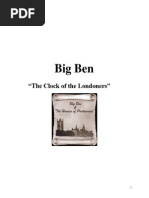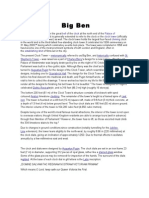Palace of Westminster London Extended To Refer Clock Tower Diamond Jubilee of Elizabeth II Augustus Pugin Neo-Gothic Style
Palace of Westminster London Extended To Refer Clock Tower Diamond Jubilee of Elizabeth II Augustus Pugin Neo-Gothic Style
Uploaded by
Andrei ViorelCopyright:
Available Formats
Palace of Westminster London Extended To Refer Clock Tower Diamond Jubilee of Elizabeth II Augustus Pugin Neo-Gothic Style
Palace of Westminster London Extended To Refer Clock Tower Diamond Jubilee of Elizabeth II Augustus Pugin Neo-Gothic Style
Uploaded by
Andrei ViorelOriginal Description:
Original Title
Copyright
Available Formats
Share this document
Did you find this document useful?
Is this content inappropriate?
Copyright:
Available Formats
Palace of Westminster London Extended To Refer Clock Tower Diamond Jubilee of Elizabeth II Augustus Pugin Neo-Gothic Style
Palace of Westminster London Extended To Refer Clock Tower Diamond Jubilee of Elizabeth II Augustus Pugin Neo-Gothic Style
Uploaded by
Andrei ViorelCopyright:
Available Formats
Big Ben is the nickname for the Great Bell of the clock at the north end of
the Palace of Westminster in London[1] and is usually extended to refer to
both the clock and the clock tower.[2][3] The official name of the tower in
which Big Ben is located was originally the Clock Tower, but it was
renamed Elizabeth Tower in 2012 to mark the Diamond Jubilee of
Elizabeth II.
The tower was designed by Augustus Pugin in a neo-Gothic style. When
completed in 1859, its clock was the largest and most accurate four-faced
striking and chiming clock in the world.
The tower is a British cultural icon recognised all over the world. It is one of
the most prominent symbols of the United Kingdom and parliamentary
democracy,[6] and it is often used in the establishing shot of films set in
London.
Origin
Elizabeth Tower, previously called the Clock Tower but more popularly
known as Big Ben,[3][5] was raised as a part of Charles Barry's design for a
new palace, after the old Palace of Westminster was largely destroyed by
fire on the night of 16 October 1834.[8][9] The new parliament was built in a
neo-gothic style.
Design
Despite being one of the world's most famous tourist attractions, the interior
of the tower is not open to overseas visitors, though United Kingdom
residents were able to arrange tours (well in advance) through their
Member of Parliament before the current repair works.[12] However, the
tower currently has no lift, though one is being installed, so those escorted
had to climb the 334 limestone stairs to the top.[
Journalists during Queen Victoria's reign called it St Stephen's Tower. As
MPs originally sat at St Stephen's Hall, these journalists referred to
anything related to the House of Commons as news from "St. Stephens"
(the Palace of Westminster contains a feature called St Stephen's Tower, a
smaller tower over the public entrance).[8] The usage persists in Welsh,
where the Westminster district, and Parliament by extension, is known as
San Steffan.
You might also like
- Big BenDocument3 pagesBig Benameliarizka880% (1)
- Elizabeth Tower, Palace of Westminster EssayDocument5 pagesElizabeth Tower, Palace of Westminster EssaySurayyn SelvanNo ratings yet
- MargiDocument23 pagesMargiNistor MihaiNo ratings yet
- ЛондонDocument4 pagesЛондонkomarnickiyandriy17No ratings yet
- IndexDocument10 pagesIndexManuel GallegoNo ratings yet
- Big Ben Is The Nickname For The Great Bell of The Clock at The North End of TheDocument1 pageBig Ben Is The Nickname For The Great Bell of The Clock at The North End of TheLaura Maria GalanNo ratings yet
- Big Ben: Big Ben Is The Nickname For The Great Bell of The Clock at The North End of The Palace ofDocument1 pageBig Ben: Big Ben Is The Nickname For The Great Bell of The Clock at The North End of The Palace ofBikeritaNo ratings yet
- A Ti̇rp To LondonDocument13 pagesA Ti̇rp To LondonEylül KarşıyakaNo ratings yet
- Most Visited Places in United Kingdom - : Lucrare Pentru Obtinerea Atestatului de Limba EnglezaDocument22 pagesMost Visited Places in United Kingdom - : Lucrare Pentru Obtinerea Atestatului de Limba EnglezaAndreeeaNo ratings yet
- Big Ben Is The Nickname For The Great Bell of The Clock at The North End of The Palace of Westminster in LondonDocument7 pagesBig Ben Is The Nickname For The Great Bell of The Clock at The North End of The Palace of Westminster in Londonangela mesarosNo ratings yet
- City of London St. Mary Axe Baltic Exchange Provisional IRADocument7 pagesCity of London St. Mary Axe Baltic Exchange Provisional IRAAna-Maria AenăşoaieiNo ratings yet
- Report of Object (BIG BEN)Document3 pagesReport of Object (BIG BEN)Ahmad Syaifudin MalikNo ratings yet
- Big Ben: "The Clock of The Londoners"Document16 pagesBig Ben: "The Clock of The Londoners"BaicuNo ratings yet
- Palace, A Medieval Building Complex Most of Which Was Destroyed inDocument3 pagesPalace, A Medieval Building Complex Most of Which Was Destroyed inAnamaria BăilăNo ratings yet
- Big BenDocument19 pagesBig BensuelaNo ratings yet
- London Study DevoraDocument3 pagesLondon Study DevoraGabriiela CNo ratings yet
- Big Ben: The Clock The TowerDocument1 pageBig Ben: The Clock The TowerGheorgheBNo ratings yet
- Palace of WestminstersDocument48 pagesPalace of WestminstersIndraja Rm100% (1)
- It Is Believed Big Ben Was Named After Sir Benjamin Hall, First Commissioner For Works, Whose Name Is Inscribed On The BellDocument1 pageIt Is Believed Big Ben Was Named After Sir Benjamin Hall, First Commissioner For Works, Whose Name Is Inscribed On The BellRocioLuisRodriguezNo ratings yet
- Big BenDocument5 pagesBig BenӘділ МадығұлNo ratings yet
- Big Ben - The Clock TowerDocument1 pageBig Ben - The Clock TowerPETRU DANIEL CARABULEANo ratings yet
- The Clock Tower of TheDocument4 pagesThe Clock Tower of ThePaula AndriesNo ratings yet
- LondonDocument3 pagesLondonZsofiNo ratings yet
- EnglandDocument23 pagesEnglandjuliavihtodenkoNo ratings yet
- Click To Edit Master Subtitle StyleDocument11 pagesClick To Edit Master Subtitle StyleMada KaslerNo ratings yet
- England LondonDocument2 pagesEngland LondonJustinCreationNo ratings yet
- Presentation of London SouthwarkDocument2 pagesPresentation of London Southwarkteillet.romyNo ratings yet
- London: ST Paul's Cathedral Is AnDocument3 pagesLondon: ST Paul's Cathedral Is AnNicolle13No ratings yet
- London: The Sights of LondonDocument7 pagesLondon: The Sights of LondonNatasa GlisicNo ratings yet
- Famous London SitesDocument1 pageFamous London Sites6fsr4f5nrhNo ratings yet
- The Most Famous Sights of LondonDocument11 pagesThe Most Famous Sights of LondonSzimonettaNo ratings yet
- LondonDocument5 pagesLondonskander sekriNo ratings yet
- London Landmark Photos PowerpointDocument18 pagesLondon Landmark Photos PowerpointКарина СиротюкNo ratings yet
- The Big Ben: Edifice: HeightDocument2 pagesThe Big Ben: Edifice: HeightBoris AnthonyNo ratings yet
- London PDFDocument42 pagesLondon PDFHuỳnh Lê Hương KiềuNo ratings yet
- Big BenDocument6 pagesBig BenMădălina SamoilăNo ratings yet
- Big Ben: Big Ben Is The Nickname For The GreatDocument11 pagesBig Ben: Big Ben Is The Nickname For The GreatChika CristinaNo ratings yet
- The Monuments: The Big Ben andDocument4 pagesThe Monuments: The Big Ben andfiliparmacedoNo ratings yet
- Big BenDocument6 pagesBig BenKezzaz BahmedNo ratings yet
- Presentation 1Document9 pagesPresentation 1Yassir ELMNo ratings yet
- Unit 2 - Daily Life in The United KingdomDocument43 pagesUnit 2 - Daily Life in The United Kingdommago.juegos258No ratings yet
- Lego Big BenDocument60 pagesLego Big BenVert PapillonNo ratings yet
- InglesDocument2 pagesInglesWilly Fonseca CNo ratings yet
- Street James'S ParkDocument8 pagesStreet James'S ParkIonela FloreaNo ratings yet
- Ukpowerpoint1 100401100338 Phpapp02 PDFDocument15 pagesUkpowerpoint1 100401100338 Phpapp02 PDFBernadett JoseNo ratings yet
- United Kingdom - Marea BritanieDocument29 pagesUnited Kingdom - Marea BritanieSALADRIANNo ratings yet
- London: The Most Exciting City in The WorldDocument19 pagesLondon: The Most Exciting City in The WorldZAlex Al AlexNo ratings yet
- Londra Obiective TuristiceDocument21 pagesLondra Obiective TuristiceBadicioiu LaurentiuNo ratings yet
- Parliament After Its Occupants, It Is Also Known As The 'Heart of British Politics'Document1 pageParliament After Its Occupants, It Is Also Known As The 'Heart of British Politics'MarryNo ratings yet
- This Is WorkDocument12 pagesThis Is Workapi-309958777No ratings yet
- Trip To London - TemplateDocument5 pagesTrip To London - TemplateIvan RafaelisNo ratings yet
- London - The City On The Thames: TravelDocument1 pageLondon - The City On The Thames: TravelTuxedoNo ratings yet
- April 2011 Lowersecondary StudentsDocument3 pagesApril 2011 Lowersecondary StudentsagnieszkaludwikaemerieNo ratings yet
- Tower of London, Is A Historic: Castle River Thames Central London United KingdomDocument3 pagesTower of London, Is A Historic: Castle River Thames Central London United KingdomLaura MihaelaNo ratings yet
- Tourism in London: The Big BenDocument3 pagesTourism in London: The Big BenOmar Hamido OrtegaNo ratings yet
- London's Big BenDocument3 pagesLondon's Big BenTurcan ElenaNo ratings yet
- Presentation of LondonDocument13 pagesPresentation of LondonОльга АсотоваNo ratings yet
- Big BenDocument1 pageBig BenTonya IlăNo ratings yet
- Interesting Facts About London: Unveiling the City's WondersFrom EverandInteresting Facts About London: Unveiling the City's WondersNo ratings yet



























































